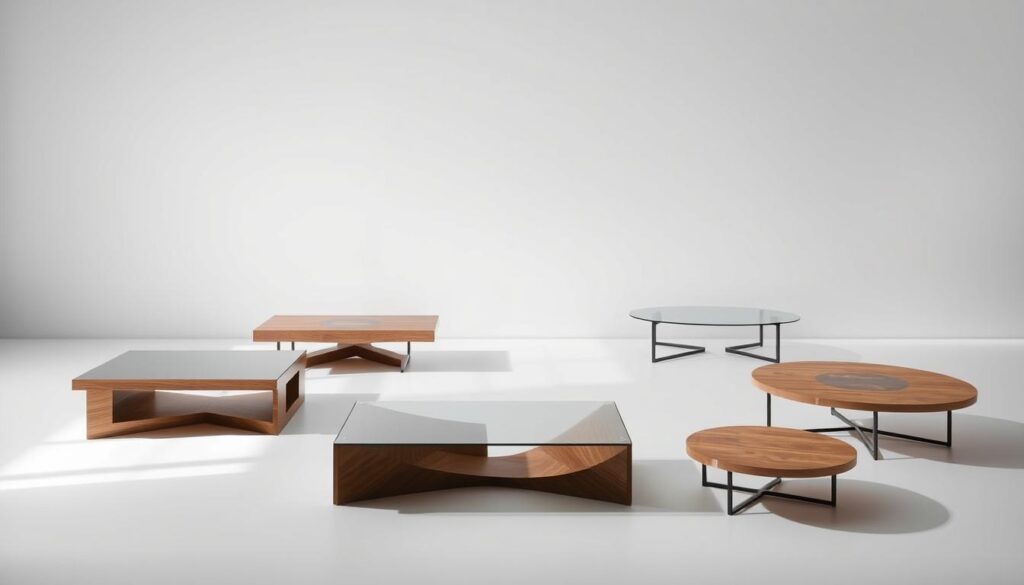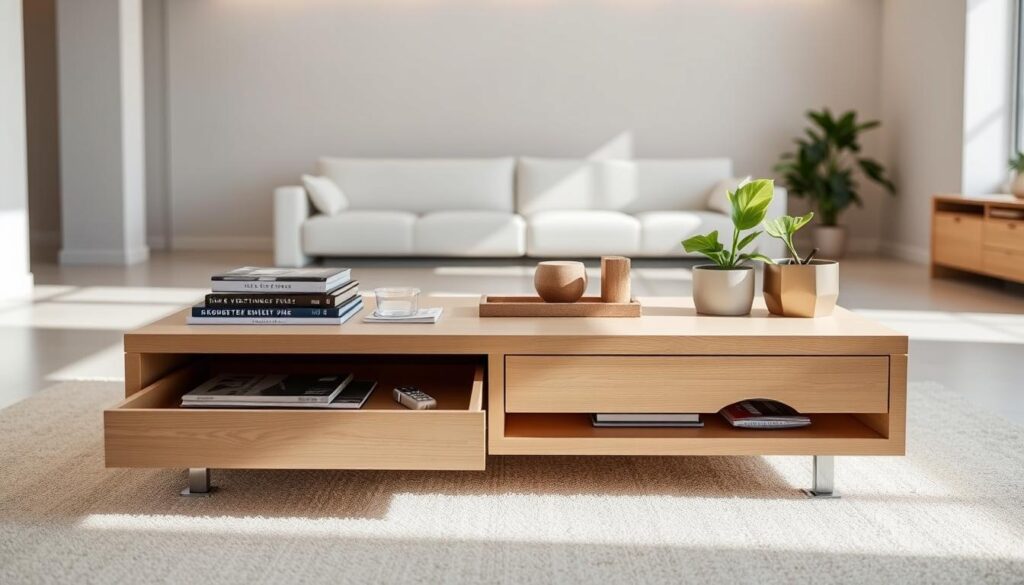Your living room deserves a centerpiece that’s both functional and fabulous. Whether you’re working with a thrifted find or refreshing a tired piece, this guide will help you turn an ordinary furniture item into a conversation-starting showstopper. Let’s explore how smart design choices can elevate your space without breaking the bank.
Inspired by brands like Lulu and Georgia, we know today’s best designs blend practicality with personality. A well-styled surface anchors your seating area while offering hidden storage or display space for books, decor, or that tray of snacks during movie night.
From modern minimalist styles to rustic farmhouse charm, we’ll walk through shape, material, and finish options to match any aesthetic. Discover how simple updates – like those featured in these 28 DIY coffee table makeover ideas – can completely transform your home’s focal point.
Key Takeaways
- Any basic piece can become a custom design statement with creative updates
- Balance visual appeal with practical features like storage or durable surfaces
- Shape and material choices dramatically impact a room’s overall style
- DIY projects offer budget-friendly ways to refresh your decor
- Trending techniques range from two-tone finishes to textured tile tops
Introduction: Setting the Stage for Your Living Room Transformation
Welcome to the heart of your home – where style meets function in the most unexpected ways. A thoughtfully selected centerpiece doesn’t just fill space; it shapes how your living room feels and functions. This versatile surface acts as both a landing pad for daily essentials and a canvas for showcasing your personality.
Why Your Centerpiece Matters More Than You Think
Design experts agree: these pieces act as social anchors, drawing people together while enhancing your space’s flow. The right choice creates visual harmony between seating areas and other furniture, making even compact rooms feel intentional. It’s not just about holding drinks – it’s about setting the mood.
Consider how proportions affect movement through your space. A too-large piece overwhelms, while a small one gets lost. The sweet spot? Leave 18 inches between your centerpiece and sofa for easy navigation. This balance lets you highlight favorite books or seasonal decor without sacrificing practicality.
Modern designs prove functionality can be beautiful. Many options now include hidden compartments or lift-top mechanisms – perfect for stashing remote controls or board games. As you’ll discover in later sections, these smart features let your focal point work harder while keeping your style effortless and organized.
Understanding Your Living Room Layout
The secret to a harmonious living space lies in its blueprint. Before selecting your centerpiece, map out existing elements to create balance. Start by measuring walkways and seating area dimensions – these numbers dictate what size works best.
Assessing Space and Furniture Flow
Grab a tape measure and painter’s tape to mark potential footprints. Experts recommend leaving 30 inches between pieces for easy movement. Try this simple test:
- Outline your ideal shape on the floor using tape
- Walk around the marked area to test traffic flow
- Adjust dimensions until pathways feel natural
This visual trick prevents buyer’s remorse. A piece that’s ⅔ the length of your sofa usually creates perfect proportion. Remember: vertical space matters too – low profiles suit compact rooms, while taller designs add drama.
Maximizing Functionality and Style
Your layout choices directly impact daily comfort and visual appeal. Consider these factors when planning:
| Factor | Ideal Feature | Style Benefit |
|---|---|---|
| Clearance | 18-24″ from seating | Modern, airy feel |
| Shape | Mirrors rug contours | Cohesive look |
| Height | 1-2″ below sofa arms | Ergonomic use |
Smart planning eliminates clutter traps. Opt for surfaces that handle daily wear while complementing your color scheme. When form meets function, your room becomes both practical and inviting – the true mark of great design.
Choosing the Perfect coffee table
Selecting the right focal point transforms both aesthetics and usability in your space. Start by measuring your room’s dimensions – a piece that’s too large overwhelms, while one that’s too small disappears. Aim for proportions that leave 18-24 inches around all sides for easy movement.
Consider how you’ll use your centerpiece daily. Need storage? Look for lift-top options or hidden compartments. Host often? Durable surfaces like tempered glass handle spills better than porous wood coffee tables. Balance these practical needs with your style – curved shapes soften angular rooms, while geometric designs add modern edge.
Material choices impact both look and longevity. While later sections dive deeper, remember this: price often reflects durability. Budget-friendly MDF works for light use, but solid wood withstands years of wear. Mix textures wisely – a sleek metal base pairs beautifully with a warm wooden top.
Test different heights using stacked books before committing. Your ideal piece should sit 1-2 inches below sofa arms for comfortable reach. Don’t forget traffic flow – oval shapes prevent bumped knees in tight spaces better than square corners.
Finally, weigh price against expected use. A $300 investment makes sense for daily-use families, while occasional hosts might prefer affordable options. Smart shoppers check secondhand markets for quality pieces needing minor updates – sanding and staining can revive dated materials.
Exploring Coffee Table Shapes and Designs
Shape defines both function and flair in your living space. The right silhouette can enhance traffic flow, highlight decor, and create visual balance. Let’s explore how different forms work with various layouts and styles.

Classic Forms for Everyday Function
Rectangular designs anchor long sofas beautifully, offering ample surface area for trays or books. Square variations create intimate seating arrangements, perfect for board game nights. Round options soften angular rooms while preventing bumped knees in tight spaces.
These timeless shapes pair well with traditional and modern styles. A wood coffee piece in organic tones adds warmth, while glass tops maintain an airy feel. For small rooms, consider nesting square coffee tables – they tuck neatly under each other when not in use.
Unexpected Silhouettes Make Statements
Oval shapes combine round’s safety with rectangular’s surface space – ideal for families. Geometric designs with hexagonal or triangular bases add artistic flair. Organic forms like free-edge live wood bring nature indoors.
Current trends favor curved edges over sharp corners. A round coffee table with metallic accents complements mid-century decor. For farmhouse charm, try a reclaimed rectangular coffee piece with chunky legs.
Always measure your space before choosing. A well-proportioned shape improves both look and usability. Mix materials like stone tops with metal bases for added texture. Your centerpiece should feel intentional, not accidental.
Material Matters: Wood, Glass, and More
The foundation of your living space’s character lies in material choices. Every surface tells a story through texture, color, and practicality. Let’s explore how different options balance beauty with everyday use.
Comparing Texture, Durability, and Maintenance
Wood brings organic warmth and hides minor scratches well. Solid oak or walnut ages gracefully, while engineered options offer budget-friendly versatility. However, liquid spills require quick cleanup to prevent stains.
Glass tops create visual lightness but show fingerprints instantly. Tempered versions withstand heat better than basic panels. While ideal for airy spaces, they’re less practical for homes with active kids or pets.
| Material | Best For | Maintenance Level | Style Impact |
|---|---|---|---|
| Wood | High-traffic areas | Moderate | Warm, timeless |
| Glass | Small spaces | High | Modern, sleek |
| Metal | Industrial decor | Low | Edgy, cool |
Practical Tips for Material Selection
Consider your daily routine first. Busy households benefit from scratch-resistant laminates or distressed woods. For formal spaces, polished stone adds luxury without constant upkeep.
Mix materials for visual interest – try a metal base with a wooden top. This combo works beautifully in farmhouse-inspired designs. Lighter tones make rooms feel spacious, while dark finishes add cozy depth.
Always test samples under your room’s lighting. Natural textures like live-edge slabs become focal points, while glossy surfaces reflect light creatively. Your choice should feel inviting to the touch while matching your color scheme.
Coffee Table Storage Solutions for a Clutter-Free Approach
Smart storage transforms your living space from chaotic to curated. Built-in compartments let you tuck away daily essentials while showcasing decorative accents. This dual-purpose approach keeps surfaces inviting without sacrificing practicality.

Incorporating Drawers, Shelves, and Lift-Top Designs
Modern furniture shines when form meets function. Lift-top mechanisms create instant workspaces while hiding remote controls or magazines. Deep drawers corral blankets, and open shelves display favorite books artfully.
Popular options include:
- Nesting sets: Stack smaller units under larger ones for flexible configurations
- Hidden compartments: Secret storage under table surfaces or within legs
- Modular systems: Adjustable shelves that adapt to changing needs
| Storage Type | Best For | Style Impact |
|---|---|---|
| Lift-top | Multi-tasking spaces | Sleek, modern |
| Drawers | Private item storage | Traditional charm |
| Open shelves | Display-ready organization | Airy, casual |
Keep surfaces clutter-free with these strategies:
- Use decorative trays to corral small items
- Rotate displayed objects seasonally
- Store bulky electronics in lower shelves
Vertical storage solutions maximize space efficiently. Taller designs with multiple tiers handle board games or throw pillows beautifully. Remember: Clever organization should feel effortless, not overwhelming.
Styling Your Coffee Table: Elevate Your Living Space
Transform your living area’s focal point into a curated display that sparks joy and conversation. The right arrangement turns a functional surface into an artistic expression of your personality. Let’s explore how to layer elements without creating visual clutter.
Accessorizing with Books, Candles, and Greenery
Start with stacked books as your foundation. Choose titles with colorful spines or textured covers. Add height with a sculptural vase holding fresh eucalyptus. Anchor the look with a ceramic bowl for remote controls or decorative stones.
| Element | Purpose | Style Tip |
|---|---|---|
| Books | Adds height & personality | Use odd-numbered stacks |
| Candles | Creates ambiance | Cluster varying heights |
| Plants | Brings life to space | Choose low-maintenance succulents |
Balancing Minimalism with Decorative Flair
Edit your display like a gallery curator. Leave 40% of the surface empty for drinks or snacks. Mix matte and glossy finishes to add depth. A metallic tray corrals smaller items while reflecting light beautifully.
Try this formula for visual harmony:
- 1 large statement piece (bowl/art object)
- 2 medium elements (books/candle trio)
- 3 small accents (coasters/mini plant)
Rotate accessories seasonally – swap pinecones for seashells, or velvet pumpkins for citrus fruits. Your living room centerpiece should evolve with your mood and the calendar, always feeling fresh yet intentional.
Budgeting and Quality: Finding the Right Price Point
Smart shoppers know great style doesn’t require maxing out credit cards. The sweet spot lies in matching your budget to materials and craftsmanship that deliver lasting value. Start by measuring your sofa – a piece should span two-thirds of its length to maintain visual balance.
Evaluating Cost Against Design and Functionality
Price often reflects durability. A $200 laminate option works for occasional use, while $600 solid wood withstands daily wear. Consider how often you’ll use the piece:
- Daily households: Prioritize scratch-resistant finishes
- Entertainment-focused spaces: Opt for spill-proof surfaces
- Small apartments: Choose space-saving nesting designs
| Price Range | Best Features | Lifespan |
|---|---|---|
| $150-$300 | Engineered wood, basic storage | 3-5 years |
| $400-$700 | Solid construction, warranty | 7-10 years |
| $800+ | Heirloom materials, custom sizing | 15+ years |
Leave 18-24 inches between your sofa and centerpiece – this size guideline prevents a cramped feel. Budget-conscious buyers can refresh secondhand finds with new hardware or paint. Remember: A well-proportioned design elevates your entire room’s aesthetic, making thoughtful spending worthwhile.
Final Touches for a Beautiful Living Room Look
The true magic of interior design reveals itself in the details. Your refreshed centerpiece now needs to harmonize with the entire space, creating visual conversations between furniture and decor. Let’s explore how to make every element feel intentionally connected.
Creating Visual Harmony Through Design
Start by echoing your color scheme across soft furnishings and decorative accents. A throw pillow matching your centerpiece’s finish ties the look together. For open-concept home layouts, repeat materials from your dining area chairs or family room shelves.
Three essential connections for cohesion:
- Texture repetition (wood grains, metallic finishes)
- Proportional balance with adjacent seating
- Lighting that complements surface materials
| Element | Connection Strategy | Impact |
|---|---|---|
| Rug Patterns | Match table base shape | Grounds the space |
| Wall Art | Coordinate with surface tones | Elevates walls |
| Light Fixtures | Mirror metal finishes | Unifies lighting |
Consider sightlines from dining and family zones – your centerpiece should enhance views from every angle. A well-integrated design makes the entire living room feel curated yet comfortable.
Add personality through rotating accessories: seasonal trays, art books, or sculptural objects. Remember – your space should tell your story while maintaining effortless functionality for daily life.
Conclusion
Crafting a stunning living space starts with one transformative element. By assessing your room’s flow, selecting durable materials, and balancing budget with quality, you’ve gained the tools to reimagine any basic piece. Remember: your centerpiece anchors both style and function, setting the stage for memorable moments.
Thoughtful design choices—like matching shapes to your sofa’s proportions or opting for multi-functional storage—turn ordinary furniture into conversation starters. Don’t shy away from mixing textures and heights when styling; stacked books paired with greenery add personality without clutter.
Ready to begin? Explore creative updates that reflect your unique taste, whether through bold finishes or artful accessories. Your dream living area awaits—one inspired decision at a time.

